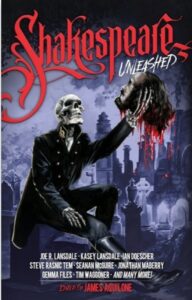

Ask anyone in the know about the history of horror, and one of the first authors you’ll hear named will be Ann Ward Radcliffe, author of The Mysteries of Udolpho. While Horace Walpole’s The Castle of Otranto is considered the first Gothic novel, The Mysteries of Udolpho, along with Matthew Lewis’ The Monk, are often mentioned in the next breath.
Gothic fiction usually takes place in faraway times and places, in a foreboding atmosphere. There are often castles, mazes, ruined buildings, wild landscapes, and mysterious or supernatural happenings. A dark atmosphere and setting are an essential part of the Gothic novel. Curious heroines, sinister and passionate villains, and irreproachable heroes all populate Gothic tales. The forbidden and hidden add to the thrills and suspense.
At the time she was writing her thrilling novels (and she wrote more than just one) writing was not considered a suitable occupation for a woman, and many women authors wrote anonymously or under a pseudonym. Radcliffe, with the support of her husband, a journalist, wrote her novels under her own name. A bestselling author, the appearance of a new book by Ann Radcliffe was an event in the literary world.
Yet we know very little about who Ann Radcliffe really was. Born in 1764 to William and Ann Ward, she had an uncle who was able to expose her to literature and art at a young age, although it is likely she received no more formal education than other young women of her time. Her husband, William Radcliffe, was a journalist, and encouraged her writing. She traveled often, although not always far from home, and her journals are filled with extensive descriptions of scenery and the natural world. This is reflected in her writing– reviews on Amazon vary between praising her gorgeous descriptive writing and skill at establishing setting, and impatience at the pace of the novel, as it slows the action down considerably. What isn’t contained in her journals is anything indicating what she might have been thinking. We don’t know why she wrote what she did, or why, at the young age of thirty two, she set down her pen. Mrs. Radcliffe died on February 7, 1823. Her works include: The Castles of Athlin and Dunbayne (1789), A Sicilian Romance (1791), The Romance of the Forest (1792), The Mysteries of Udolpho (1794), A Journey Made in the Summer of 1794, through Holland and the Western Frontier of Germany, with a Return down the Rhine: to which are added Observations during a Tour to the Lakes of Lancashire, Westmoreland, and Cumberland (1795) and The Italian (1796). (Gaston de Blondville and some poetry was published posthumously)
Radcliffe was familiar with contemporary works and also with Shakespeare. More than one of her books reflect influences from Macbeth and Hamlet, and her essay “The Supernatural in Poetry” references them directly in establishing her definitions of the difference between terror and horror (Radcliffe considered her works to inspire terror rather than horror, at least as she describes them both) Radcliffe expresses frustration with Shakespeare’s choice to present the witches from Macbeth as ordinary “Scotch women” instead of otherworldly creatures. Terror, she implies, is created by our reaction to the unearthly, and its effect is lost when it collides with the ordinary appearance of mere elderly women. Horror is a different matter entirely, a momentary excitement, rather than the subtle, unseen thrill that builds in a foreboding atmosphere which Radcliffe identifies as terror. She wrote:
Terror and horror are so far opposite, that the first expands the soul, and awakens the faculties to a high degree of life; the other contracts, freezes, and nearly annihilates them… Where lies the great difference between horror and terror, but in the uncertainty and obscurity, that accompany the first, respecting the dreaded evil?
I can’t imagine what Mrs. Radcliffe would think of seeing herself classed with horror writers today!
Even with her attempt to justify her writing as somehow more “highbrow” than horror, In Ann Radcliffe In Relation To Her Time, Clara McIntyre noted that The Mysteries of Udolpho was written to appeal to the general public, and she posits that Radcliffe was one of the earliest contributors to dramatic structure in fiction– that is, the creation of suspense to drive action, and action to complicate events that later have to be resolved. While today, Radcliffe’s hefty tomes may be slow going, McIntyre writes:
“The greater complication of the plot, the wider range of experience to which we are introduced, the increased number of thrills and surprises, and the really remarkable description of the Castle of Udolpho, all were calculated to appeal to the popular taste. Even now the charm has not wholly departed, if, forgetting to read critically, we submit ourselves to its power. We feel a little shiver of apprehension when the black pall on the .bed slowly begins to rise… ” (42)
It would be interesting to learn more about Mrs. Radcliffe, but there are so few facts to be had. Even if one doubts the literary quality of her work, though, her use of suspense to create a dramatic narrative, her descriptive writing, and her ability to evoke deep emotions and create unearthly chills had a permanent effect on English literature, and especially on the romance and horror genres. It’s worth while to take a moment to consider what Ann Radcliffe’s inner thoughts must have been as she created her fantastic and terrifying stories.
Editor’s note: As soon as this blog post was published, The Guardian reported the discovery of a letter by Ann Radcliffe that may offer some insight into her personal life. Evidently she had mother-in-law issues.






Follow Us!